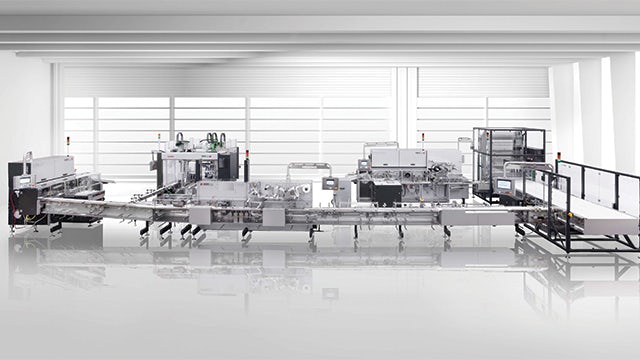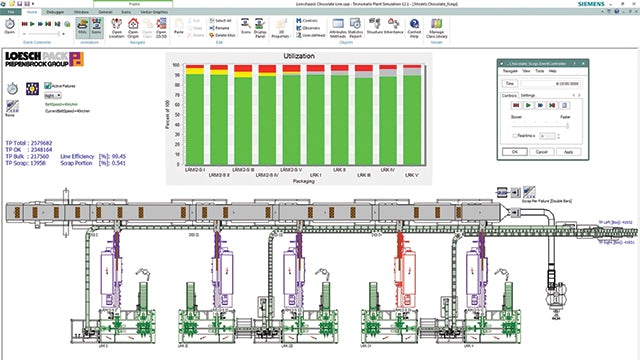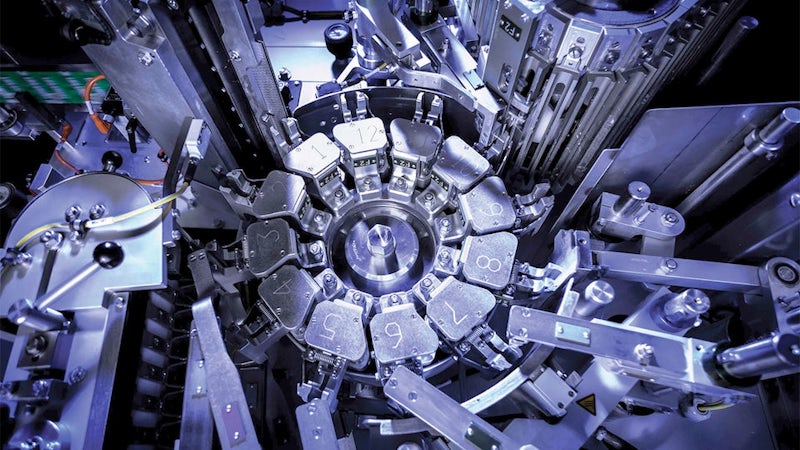Using Plant Simulation to produce high-performance packaging systems for the confectionary industry
Siemens Digital Industries Software solution enables LoeschPack to optimize and validate planning and commissioning of packaging machines and systems
Loesch Verpackungstechnik GmbH (LoeschPack)
Loesch Verpackungstechnik GmbH (LoeschPack) is a leading international company in the development, manufacture and full service of packaging machinery and complete packaging systems for confectionary products, in particular chewing gum, chocolate and long-life bakery goods as well as other food and non-food products.
http://www.loeschpack.com- Headquarters:
- Altendorf, Bavaria, Germany
- Products:
- General, Tecnomatix
- Industry Sector:
- Industrial machinery
By using the visualization capabilities of Plant Simulation, our customers get a clearer understanding of the packaging process so they can understand what happens when failures occur, and they know which parameters have been specified and how the constraints have been defined.
LoeschPack, Altendorf
Ever-increasing complexity
Loesch Verpackungstechnik GmbH (LoeschPack) is a leading international company in the development, manufacture and full service of packaging machinery and complete packaging systems. Exports account for 90 percent of the company’s revenue. The focus of LoeschPack’s offerings is packaging systems for confectionary products, including chewing gum, chocolate and long-life bakery goods as well as other food and non-food products. The company was founded in 1919 in Dresden, Saxonia, Germany and was reestablished after World War II in 1949 by former employees. It is now located in Altendorf, Upper Franconia, a region in Bavaria, and has about 300 employees. LoeschPack has been part of the Piepenbrock Group since 1982.
The confectionary industry is one of the fastest-growing food sectors. New packaging ideas require innovative technical concepts for packaging machines and systems. Meeting today’s demanding challenges requires not only expertise but also the use of state-off-the art software tools to support the planning of complex packaging processes.
LoeschPack’s packaging systems consist of machines for single or multiple packaging steps, and supplying, sorting and transporting components for products and packaging materials as well as buffers.
Tobias Hetzer, deputy head of project engineering at LoeschPack, explains: “Our customers are looking with increased regularity for complete solutions, with one responsible supplier, mainly to avoid interface problems. In addition, they need to know in advance the efficiency of these solutions: What is fed into the system and what is the output of quality products, at which rate?”
Therefore, a central focus at LoeschPack is the development and delivery of complete packaging solutions. In addition to the clear benefits customers receive by getting an overall solution from one source, it is also important for LoeschPack to secure future growth as it competes against other vendors that only offer single solutions.
“Of course we like to satisfy our customers and to meet their expectations,” says Hetzer. “To fulfill this, we need to verify the efficiency of the complex packaging systems – which have to handle mostly fragile confectionery products – early in the planning process.”
He notes, “This task requires us not only to know the efficiency of single machines or components, we also need to find out how many machines are needed per single packaging step, how big the buffers have to be, and what influence short malfunctions will have on the overall process and efficiency.”
Because these tasks cannot be solved in a secure and efficient way without a suitable software solution, in 2012 LoeschPack began to look for a solution that best fit their specific requirements. As part of the selection process, several solutions were used on real projects with the help of simulation-service providers as well as in-house resources.

Packaging system with high-performance flow and fold wrapping machines for chocolate bars.
Selection process based on real customer projects
The proposal process varies based on specific customer requirements. Potential customers may have a clear idea of what they need, or they may need to optimize their processes for products that are already on the market. But sometimes customers do not really know what they need. That’s when the expertise of LoeschPack representatives enables them to work with the customer to come up with an appropriate solution. In most cases, the only way to provide secure verification of the developed concepts is with a simulation tool, which should be easy and flexible to use and deliver reliable results.
After installation of a system, additional machines or components might need to be implemented. Therefore, without a secure upfront digital simulation a manufacturer can run into problems. If such costly problems can be avoided by implementing a digital simulation tool, the return on investment for the software acquisition and costs of ownership pays off in a short amount of time.
Hetzer explains: “In a big project in Brazil, we had a specific issue to solve, but it was difficult without a simulation tool. At that time Andreas Behrens, our deputy manager and leader for design and development, remembered seeing a demonstration of Plant Simulation. We successfully conducted a project with Siemens Digital Industries Software using Plant Simulation. After this project, we decided to look for a tool to use in-house so that in the future we would not need to rely on service providers.”
In addition to the Plant Simulation solution in the Tecnomatix® portfolio, LoeschPack tested other simulation tools. Among the possible candidates was software that was specifically designed for simulating packaging. However, none of the software was compelling since they were not equally easy to operate or lacked flexibility.
Picking Plant Simulation
“We decided to go with Plant Simulation because it is flexible, we can model our current and future projects precisely, and because it is easy and intuitive to use,” says Hetzer. “In addition, Plant Simulation offers good visualization of the processes and displays results in a variety of formats.”
LoeschPack was also impressed that Plant Simulation software is used by a large number of leading manufacturing companies and that there are many service providers offering simulation services with Plant Simulation. This could be an advantage when the internal simulation capacities are not sufficient due to high workload. Since the beginning of 2015, the software has been in productive use at LoeschPack.

Packaging system with counter-mold handling and high-performance fold wrapping machine for small chocolate products.
The simulation process
The digital simulation of a packaging system starts with the definition of a simulation model. Plant Simulation offers simulation modules, which refer to the different machines and components of a packaging system. Modules can be added or modified, then configured into a complete packaging system. Ideally, the modules are placed in a customer-provided plant layout to show a realistic 2D- or 3D-representation of the system.
After that, parameters are added to the single components. These can be the product size, distances between the single tasks, frequencies of the packaging processes, the capacity of buffers, or key figures for possible failures and changeover times. Plant Simulation enables the user to automatically change parameters in specified steps, facilitates the fast simulation of different scenarios, and provides realistic insight into the influence of buffer sizes or failures on the whole process and the efficiency of the complete system.
Furthermore, Plant Simulation can be used to compare different line executions to balance costs and effects to increase efficiency.

Digital simulation of a chocolate bar packaging system with Plant Simulation: product distribution, primary and secondary wrapping, and consolidated transport.
A positive experience
LoeschPack’s experience with Plant Simulation has been extremely positive: “The previously mentioned big-scale system in Brazil, where we used Plant Simulation for the first time, has run flawlessly ever since then. Today the digital simulation is already a big help for us in many areas, internally as well as in communication with our customers. LoeschPack and our customers get greater reliability in the dimensioning of our systems. By using the visualization capabilities of Plant Simulation, our customers get a clearer understanding of the packaging process so they can understand what happens when failures occur, and they know which parameters have been specified and how the constraints have been defined.”
LoeschPack realizes other benefits because more concept variants can be tested in a short time. This even makes it possible to find entirely new, more cost-effective or more efficient solutions. Another advantage concerns the commissioning of the packaging systems. Using close cooperation between the planning engineers and the machine control programmers, validated parameters and other information can be directly used for the programming task. This can reduce the commissioning time and substantially improve quality.
Outlook
LoeschPack will increase its internal simulation competency and capacity further with the support of Siemens Digital Industries Software.
LoeschPack envisions extending the use of Plant Simulation for virtual commissioning, which is the testing of planning and control data on a “virtual machine,” and the direct transfer of the validated data into the controllers of the real machine. Another aspect of this could be to expand the use of the software to achieve better security, productivity and energy efficiency, which is becoming increasingly important.
We decided to go with Plant Simulation because it is flexible, we can model our current and future projects precisely and because it is easy and intuitive to use.
LoeschPack, Altendorf
